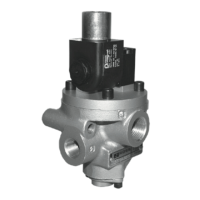Pneumatic equipment should be maintained only by persons
trained and experienced in the maintenance of such equipment.
Supply Clean Air. Foreign material lodging in valves is a major cause
of breakdowns. The use of a 5-micron rated air filter located close to
the valve is strongly recommended. The filter bowl should be drained
regularly, and if its location makes draining difficult, the filter should
be equipped with an automatic drain.
Check Lubricator Supply Rate. A lubricator should put a fine oil mist
into the air line in direct proportion to the rate of air flow. Excessive
lubrication can cause puddling in the valve and lead to malfunctions.
For most applications an oil flow rate in the lubricator of one drop
per minute is adequate. (Note that the double valve itself does not
require air line lubrication.)
Compatible Lubricants. Although this valve does not require air
line lubrication, it may be used with lubricated air being supplied to
other mechanisms. Some oils contain additives that can harm seals
or other valve components and so cause the valve to malfunction.
Avoid oils with phosphate additives (e.g., zinc dithiophosphate), and
diester oils; both types can harm valve components. The best oils
to use are generally petroleum base oils with oxidation inhibitors,
an aniline point between 180°F (82°C) and 220°F (104°C), and an
ISO 32 or lighter viscosity.
Some compatible oils are listed above at the right. These oils,
although believed to be compatible, could change without notice
because manufacturers sometimes reformulate their oils. Therefore,
use oils specifically compounded for air line service. If it is a synthetic
oil, contact the oil manufacturer for compatibility information.
Cleaning the Valve. If the air supplied to the valve has not been
well filtered, the interior of the valve may accumulate dirt and varnish
which can affect the valve’s performance.
This can cause sluggish or erratic valve action and nuisance
lockouts. A schedule should be established for cleaning all valves,
the frequency depending on the cleanliness of the air being supplied.
COMPATIBLE LUBRICANTS
Maker Brand Name
Amoco ...............American Industrial Oil 32
Amoco Spindle Oil C, Amolite
32
Citgo .................Pacemaker 32
Exxon ................Spinesstic 22, Teresstic 32
Mobil .................. Velocite 10
Non-Fluid Oil .....Air Lube 10H/NR
Shell ...................Turbo T32
Sun ....................Sunvis 11, Sunvis 722
Texaco ...............Regal R&O 32
Union .................Union Turbine Oil
2 ROSS CONTROLS
®
VALVE MAINTENANCE
To clean the valve use any good commercial
solvent. Do not scrape varnished surfaces. Also do
not use chlorinated solvents or abrasive materials.
The former damages seals, and abrasives can
do permanent damage to metal parts. Before
reassembling the valve, lubricate all sliding surfaces
with a grease such as MobilGrease 28.
Electrical Contacts. In the electrical circuits
associated with the valve solenoids, keep all
switches or relay contacts in good condition to avoid
solenoid malfunctions.
Replace Worn Components. In most cases it is not
necessary to remove the valve from its installation
for servicing. However, turn off the electrical power
to the valve, shut off the air supply, and exhaust the
air in the system before beginning any disassembly
operation. Service kits are listed on page 2.
You may also request a free service manual from
ROSS in the U.S.A. at 1-800-GET-ROSS.
Applicable Requirements: C22.2 No. 0-10 - General Requirements - Canadian Electrical Code, Part II; CSA C22.2 No.
25-1966 - Enclosures for use in Class II Groups E, F and G Hazardous Locations; CSA C22.2 No. 142-M1987 - Process
Control Equipment; C22.2 No. 213-M1987 - Nonincendive Electrical Equipment for Use in Class I, Division 2 Hazardous
Locations; CAN/CSA E79-0-95 - Electrical apparatus for explosive atmospheres, Part 0: General requirements; CAN/
CSA E79-18-95 - Electrical apparatus for explosive atmospheres, Part 18: Encapsulation "m".
APPROVED for use in the following Hazardous Locations – Ex m II T4 and Division 1 –
Specifications in accordance to CSA certificate: Class I, Division 1, Groups A, B, C and D; Class II, Groups E, F and
G; Class III; Class I, Division 2, Groups A, B, C, D.
Specifications in accordance to FM certificate: Explosion-proof Class I, Division 1, Groups A, B, C, D, T4, Ta = 60
°C (encapsulation/explosion-proof Class I, Zone 1, AEx m II T4, Ta = 60 °C; dust-ignition-proof for Class II/III, Division
1, Groups E, F and G, T4, Ta = 60 °C); Nonincendive Class I, Division 2, Groups A, B, C, D, T4, Ta = 60 °C; Suitable for
Class II, III, Division 2, Groups E, F, G, T4, Ta = 60 °C
CSA CLASS 2258 02 – process control equipment – for hazardous locations; FM CLASS 3600, 3611, 3615, 3810 – hazardous (classified)
location electrical equipment
Explosion Protection Reference Guide

